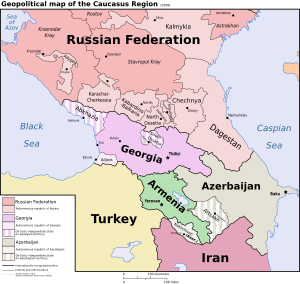Transcaucasia facts for kids
Transcaucasia is a region located near the southern Caucasus Mountains. It sits on the border between Eastern Europe and Western Asia. This area includes the modern countries of Georgia, Armenia, and Azerbaijan. These countries together cover about 186,000 square kilometers (71,850 square miles). Transcaucasia is also known as the South Caucasus. It is part of the larger Caucasus region, which divides the huge landmass of Eurasia.
Contents
Exploring the Geography of Transcaucasia
Transcaucasia covers the southern part of the Caucasus Mountains and their lower lands. It stretches across the border of Europe and Asia. The region goes south from the Greater Caucasus mountains in southwestern Russia. It reaches the borders of Turkey and Armenia. To the west, it touches the Black Sea, and to the east, it meets the Caspian Sea coast of Iran.
This area includes the southern part of the Greater Caucasus range. It also has the entire Lesser Caucasus mountain range. Other features are the Colchis Lowlands, the Kura-Aras Lowlands, and the Talysh Mountains. The Lankaran Lowland and parts of the Armenian Highland are also here.
All of modern Armenia is in Transcaucasia. Most of Georgia and Azerbaijan are also in this region. This includes the separate part of Azerbaijan called Nakhchivan. Some parts of Iran and Turkey are also considered part of Transcaucasia.
Natural Resources and Products
The region produces important goods. These include oil and manganese ore. Farmers also grow tea, citrus fruits, and grapes for wine. Transcaucasia is a region with some political challenges. It has three areas where control is debated: Abkhazia, South Ossetia, and Nagorno-Karabakh.
A Look at the History of Transcaucasia
Ancient historians like Herodotus and Strabo wrote about the early peoples of the Caucasus. Over time, many different groups settled here. These included the Scythians, Huns, Arabs, and Mongols. These groups influenced the culture of the people in Transcaucasia. Also, ideas from the Middle East brought Iranian languages and the Islamic religion to the area.
Empires and Influences
Transcaucasia has been a place of many changes for centuries. It is located near the powerful empires of Iran, Russia, and Turkey. Many empires have controlled this region throughout history. These include the Achaemenid Empire, the Roman Empire, and the Ottoman Empire. Each empire brought its own beliefs and ways of life. For a long time, Transcaucasia was often part of the Iranian world.
In the 1800s, the Russian Empire took control of the region. This happened after two wars with the Qajar rulers of Iran. The Treaty of Gulistan (1813) and the Treaty of Turkmenchay (1828) gave Russia control over much of modern-day Georgia, Armenia, and Azerbaijan.
Ancient Kingdoms and Religions
Some ancient kingdoms in the region were Armenia, Caucasian Albania, and Caucasian Iberia. These kingdoms later became part of various Iranian empires. During this time, Zoroastrianism was a main religion. However, when Christianity became popular, many Caucasian kingdoms adopted this new religion. This led to conflicts between Christian and later Muslim empires.
Modern History and Republics
After the Russian Revolution in 1918, the Russian Empire fell apart. Transcaucasia briefly became a single country twice. First, it was the Transcaucasian Democratic Federative Republic (1918). Later, it was the Transcaucasian Socialist Federative Soviet Republic (1922-1936). Both times, it split into the separate countries of Armenia, Azerbaijan, and Georgia.
In August 2008, the Russo-Georgian War took place in Transcaucasia. This event added to the challenges in the region. The area has a mix of religions, mainly Muslim and Orthodox Christian. It also has many different ethnic groups.
Transcaucasia: The Birthplace of Wine?
Transcaucasia is a very old region for growing grapes. Specifically, the areas that are now Turkey, Georgia, Armenia, and Iran are home to the Vitis vinifera vine. This is the main type of grape used to make wine.
Some experts believe that wine production first started in Transcaucasia. Scientists have found very old grape seeds in the area. These seeds date back to 7000–5000 BC. Wine found in Iran has been dated to about 7400 BC and 5000 BC. Wine found in Georgia dates back to about 6000 BC. The oldest known winery was found in Armenia. It is about 6,000 years old.
Images for kids
See also
 In Spanish: Transcaucasia para niños
In Spanish: Transcaucasia para niños





